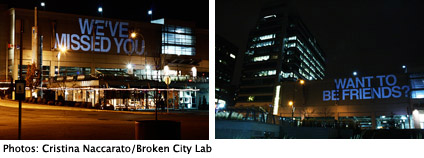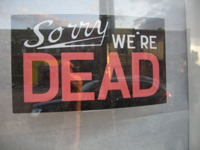Fixing a Broken City
by Nate Berg
MetropolisMag.com
November 24, 2009

Just across the river from Detroit sits a city forgotten. Battered by the fall of the auto industry and struggling to keep its economy running, Windsor, Ontario, has seen some tough times in recent years, and things aren”™t likely to improve any time soon. It has the highest unemployment rate in Canada, a plummeting population, and the empty storefronts and foreclosed homes that have come to define this generation”™s Great Recession.
Though geographically south, Windsor”™s been called the Detroit of the North. For some locals, it”™s simply a broken city. But there”™s a growing movement that believes Windsor is a city that can be fixed.
Read the rest of this article about the work of the Broken City Lab here.
Related:
Welcome to Detroit
by Elizabeth Evitts Dickinson
MetropolisMag.com
September 3, 2009
 Within hours of arriving in Detroit, nearly $14,000 worth of computers, iPods, cameras, and art supplies went missing from the backseat of a car. The robbery was surprisingly quick, executed in the few minutes the vehicle was left unguarded on the street. The two victims knew better than to leave valuables in plain site, yet they hadn”™t quite expected the crime. Neither had they backed up their hard drives properly, so the loss was more than just monetary.
Within hours of arriving in Detroit, nearly $14,000 worth of computers, iPods, cameras, and art supplies went missing from the backseat of a car. The robbery was surprisingly quick, executed in the few minutes the vehicle was left unguarded on the street. The two victims knew better than to leave valuables in plain site, yet they hadn”™t quite expected the crime. Neither had they backed up their hard drives properly, so the loss was more than just monetary.
Welcome to Detroit.
The irony of the reception is that the victims had come to town to positively engage the city through Project M, an intensive immersion program founded by the graphic designer John Bielenberg. Since it began in 2003, Project M has rallied design students and professionals from Alabama to Iceland to go out and design for the greater good. Jeff Caldwell of San Francisco”™s the Vega Project, a longtime Project M advisor and a Detroit native, organized this two-week event, collaborating with Doug Kisor, the chair of the graphic design department at the city”™s College for Creative Studies. The goal: connect with communities, push the creative bounds of design practice, and confront real problems.
Read the rest of this article here.
